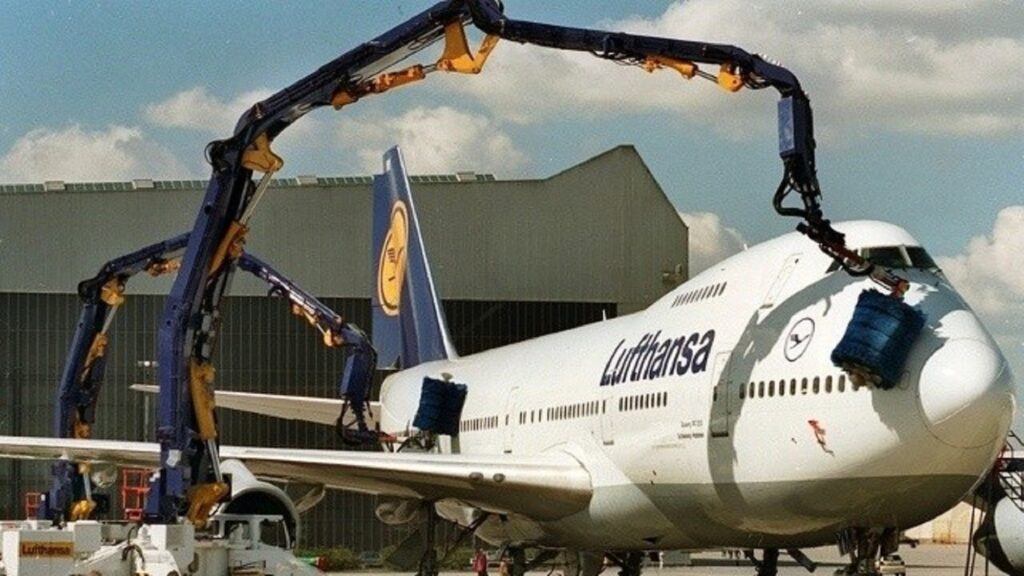The exterior of an airplane is usually cleaned with water and soap, or, it can be “dry-cleaned” using specialized chemicals.
In the case of conventional airplane cleaning, soap is first applied to dirty areas of the fuselage surface. Then, strong, high-pressure water is sprayed onto the surface to rinse off the soap and dirt.

But before that can happen, every sensor and opening on the fuselage has to be covered up to protect against water ingestion and damage. In the picture below, the static ports are sealed with tape before the washing commences:

Since a commercial airplane is so colossal, thousands of litres of water are needed to clean off dirt ingrained on the surface of the fuselage. Since clean water is a precious commodity, such a cleaning method can be seen as a waste of resources.
Hence, a new cleaning method was developed to make airplane cleaning more environmentally friendly. Emirates uses an aircraft ‘drywash’ technique to chemically remove stains from their aircraft.
A special cleaning agent is applied onto the airplane surface. The agents dissolve the sticky dirt. Then, workers wipe the agent and the dirt off with mops.



Emirates claims that 11.7 million liters of water are saved annually with drywash. With this cleaning method, their planes are cleaned with “little or no water”, and they only need to be drywashed three times a year.

Some airlines also employ mops to scrub their planes clean.

It’s worth noting that the purpose of cleaning airliners isn’t purely cosmetic.
Southwest Airlines strategically schedule washes for their Boeing 737s. Every jet is arranged to be cleaned a day before it is due for a C check. This allows maintenance personnel to perform inspection works more efficiently, and identify any cracks and defects on the fuselage much more easily.
A clean plane—with no grime on its fuselage surface—is more aerodynamic and therefore more fuel efficient.
For airplane interior cleaning, shampoo is applied to the carpet flooring, and then vacuumed away.

The same goes for the galley and lavatory floor.

The tray tables and armrests are wiped with anti-bacterial solution.
The dirty seat covers get replaced with freshly washed ones.

However, such an extensive cleaning process, known as ‘deep cleaning’, don’t occur after every flight. Rather, they are conducted when the plane completes its flights for the day.
In between flights, the ground crew completes a ‘clean sweep’ of the cabin, taking out trash, dirty pillows and blankets. The floor may be swiftly vacuumed and mopped. The seats and tray tables may be wiped and disinfected. However, nothing gets cleaned in detail.
How extensive the ‘clean sweep’ is will depend on how much time the plane has on the ground.
Budget and regional airlines tend to have a short turnaround time between two flights. This means they have a limited time to disembark passengers, clear the airplane, clean, board new passengers, load new cargo and depart again for another flight. Thus, the ground staff would have to clean the cabin hastily to avoid a delay. Consequently, the clean job would often be sloppy. The toilets and tray tables may be neglected. The carpet beneath the seats may not be vacuumed.
However, in between long-haul flights, the cleaning crew would have more turnaround time to prepare the aircraft.
Well-established airlines would clean their planes more decently to avoid staining their reputation. The first and business class sections of the cabin would likely be extensively sanitised to impress the high-paying customers, whereas the economy class section might receive less attention. Nonetheless, airlines (should) work to ensure their planes are properly sterilised to prevent the spread of germs between countries and continents.
As standard procedure, the cockpit gets disinfected with wet wipes.

And, the cockpit windows are cleaned like so:

In conclusion:
- The exterior of the plane is either cleaned by soap and a powerful jet of water, or by drywashing.
- The interior can either undergo a ‘clean sweep’ or a more rigorous cleaning process, called a ‘deep clean’. The cabin floor is shampooed and vacuum cleaned. The seat covers are either wiped clean or replaced with fresh ones. The tray tables and armrests are wiped with anti-bacterial cleaning agent.
- The quality of the cabin clean-up will usually depend on the quality of the airline, and the amount of time the cleaning crew is given.
Author – Isaac






